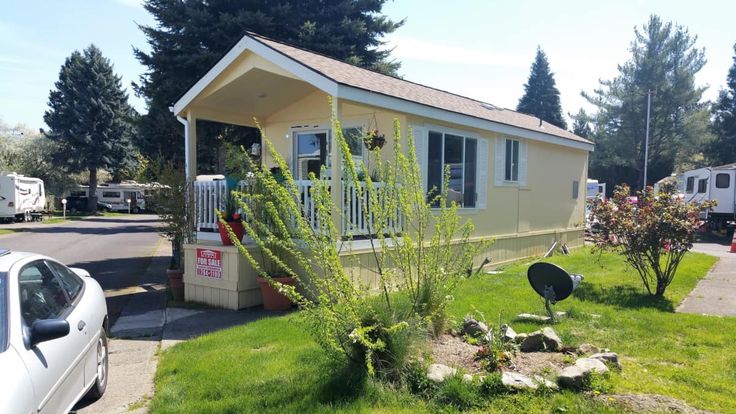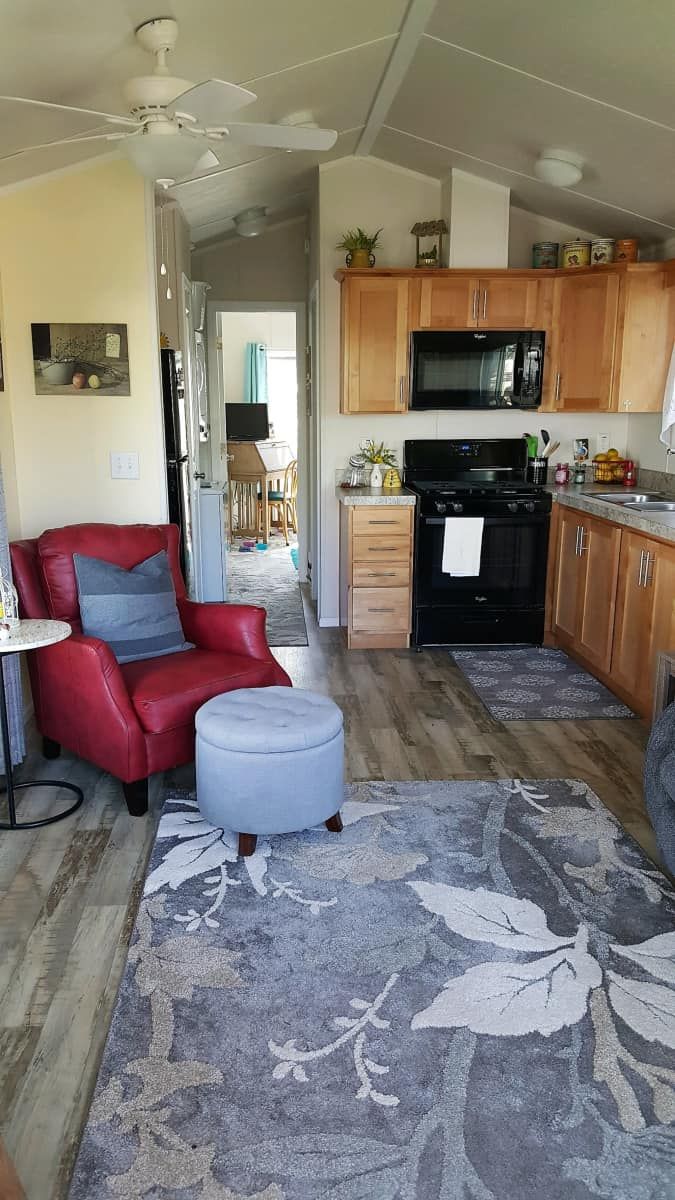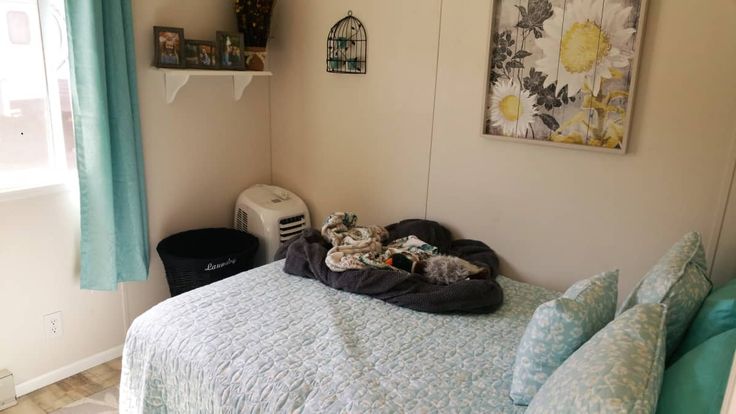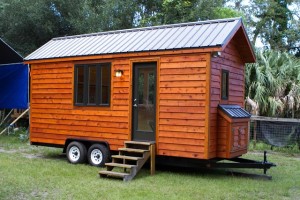This post contains affiliate links.
This is a guest article by Shaylynn Bates – “How she got her tiny house and ways you can too”
With all the articles out there about downsizing and living small, I’m sure the title of this article is very misleading. I’m not writing yet another article warning about the difficulties of living in a small space and how it’s overrated, and not all it’s cracked up to be; I have lived in a 10 ft. X 10 ft. space, 600 sq. ft. with another person, and the sleeper cab of an 18 wheeler (I am a proponent of living small). One needs to have a small space in order to live in a small space. After getting my tiny house I received several requests asking for information on how I successfully got into tiny house owning. All the information out there is either (at the time of this writing) 6 years old or very vague and general. A brief overview of tiny houses will be necessary as the rest of this article will discuss financing your little dream and where to put it. “Disclaimer this information is one person’s experience in the state of Oregon, your state and your experience may be different”
First – here’s Shaylynn’s beautiful tiny home…😊

It’s a park model tiny house.

Still mobile, but wider than the tiny houses on wheels we normally see.

This gives you a better ability to have a one bedroom tiny home with everything on the main floor.

There’s even space for a stackable washer and dryer in the hallway.

Here is a look at the bedroom.


For the purpose of this article, we will be covering two types of tiny houses THOW and an ADU. You may be wondering what these acronyms stand for and what are the criteria for classification? The thought may have also popped into your head as to why these labels, titles, classifications are important ( a rose by any other name is still a rose), well it boils down to financing and we’ll get into that later. For now, let’s just get the lingo; THOW stands for Tiny House On Wheels and ADU is an Additional Dwelling Unit (that’s the name given in By some states, including Oregon).
Up until recently there have really only been 5 ways in which to finance a tiny house and my situation fell between the cracks), the particular tiny I was looking at didn’t meet the criteria.
*Finance directly through RV certified tiny house builders – [RVIA (Recreation Vehicle Industry Association) certified tiny houses] -In order for tiny home builders to be RVIA certified, they must submit to a rigorous inspection process. An RVIA sticker ensures that your tiny house on wheels is up to recreational vehicle building codes and is safe for habitation. Builders that build RVIA certified THOW’s can offer in-house financing. The original owner of my tiny was able to design and purchase the house using this method. With the RVIA certification the THOW was allowed into the RV park where it resides (not all tinys are allowed into RV parks and not all RV parks allow tinys, for example, my park doesn’t allow for bus conversions).
*Recreational vehicle (RV) loan – Banks and Credit Unions can offer an RV loan. I read in several articles” financing is more straightforward with RVIA-certified tiny houses since lenders consider them similar to RVs.” As with a traditional RV , getting a loan for a THOW is dependent upon the year, make, and model as well as a valuation (similar to an appraisal on a foundational house). My tiny is RVIA certified which is great for an original purchase, but when purchasing a used RVIA certified tiny it was irrelevant. When I applied for an RV loan I found out that lenders require the THOW to be licensed and registered through DMV (Oregon does not do this, they issue special travel permits to move the THOW). To qualify for an RV loan it needs to have an engine, therefore THOW’s get classified as travel trailers (again Oregon doesn’t do this).
*Home equity line of credit (HELOC) – If you have enough equity you could borrow against your existing mortgage that means your home acts as the collateral. So if you default on the loan, your primary house and the tiny could be seized.
*Traditional Home mortgage – If your tiny home has enough square footage (400 sq. ft. and above), complies with local building codes and sits on a permanent foundation it could qualify for a traditional mortgage designed for modular (mobile) homes. But you may also have to borrow a larger amount of money.
*Personal loan – Like RV loans, unsecured personal loans won’t require you to post any collateral to guarantee the debt.
* Tiny House Mortgage – As of December 2018 there is now a mortgage specifically designed for tiny houses. I don’t know how readily available the mortgage is, as I am the first person in a pilot program for tiny house mortgages created by 21st Century Mortgage.
Your information that is taken into account for financing:
Down Payment: 15-20% of purchase price
Credit History: 3-5 years of credit history.
Comparable loan amount in recent history.
Debt/Income Ratio: Less than 45%
No Credit Defaults: Late payments or bankruptcies.
Income: Gross annual income equal to or greater than amount being financed
So to summarize, if the tiny is on wheels and under 400 sq. ft. then look at financing for a travel trailer or RV (if your state does license and registration on THOW’s). If the tiny is on a foundation and greater that 400 sq. ft. then look into a mobile home loan. If it’s on wheels and 400+ sq. ft. I’m not sure where it fits in the financing world (that may be another “fall between the cracks” situations; if that’s the case and your situation the maybe you can partner with 21st century and help change and mold the future of housing and financing)
Part of the dilemma with tiny houses is where they are going to sit (temporarily or permanently). The rule of thumb in real estate is location, location, location. This fact will impact the tiny house you purchase. Therefore knowing some basics will help you decide what kind of tiny (on wheel, a foundation, an ADU) you will buy and where you will place it.
Every state and county within has specific zoning laws that specify whether zones can be used for residential or commercial purposes, and may also regulate lot size, placement, bulk (or density) and the height of structures. Zoning can require minimums for emergency vehicle access for safety reasons; sewer or septic connections, rainwater runoff control, municipal water or well water hookups for health reasons ( many places don’t allow for composting /incinerating toilets); minimums for lot size, square footage of houses (The most common challenge is zoning that specifies a minimum square footage for any main residence. This varies from city to city and can range from 450sq.ft. to 1,500 sq. ft.), and restrictions on how many residences can occupy a lot or given area. It is possible to apply for a variance that would allow for a tiny house despite it being smaller than the minimum size required.
Private Property- Some cities are rethinking those minimums, especially where real estate prices are high (Portland, Or. Is one of those cities, which in 2017 passed ADU legislation).This means you can add or convert a smaller building, the catch is you have to have a main house and zoning usually requires the main dwelling to be occupied by the property owner. There are other restriction, for example, the total number of residents on the property. If you go this route research you communities zoning, building (if you’re building your own), and ADU laws. If you don’t you could find yourself facing similar issues as the Bend Or. The family who had to move out or face fines https://www.oregonlive.com/business/2019/02/family-of-4-evicted-from-272-square-foot-tiny-home-in-bend.html
Land- (without specific zoning requirements) – Typically these are in more rural areas. You should call the counties environmental health department before you buy land.
Mobile home / RV park- (seasonal or extended stay) This is a great option if you want to stay put and live tiny. You can do as my tiny’s previous owner did. Or you may with patience and diligence get lucky (as I did) and find your perfect tiny already established in a park and for sale.
RV park- (Overnight/Destination) As stated earlier not all types of tinies are allowed, so call ahead (this is for the traveling homeowner).
For more info you can connect on Facebook with other tiny house aficionados, you can also check out these web sites.
https://tinyhousebuild.com/understanding-zoning-and-tiny-houses/
https://www.moneytaskforce.com/real-estate/tiny-house-laws-state-regulations/
Our big thanks to Shaylynn Bates for sharing!🙏
You can share this using the e-mail and social media re-share buttons below. Thanks!
If you enjoyed this you’ll LOVE our Free Daily Tiny House Newsletter with even more!
You can also join our Small House Newsletter!
Also, try our Tiny Houses For Sale Newsletter! Thank you!
More Like This: Tiny Houses | THOW | Park Model Tiny Houses
See The Latest: Go Back Home to See Our Latest Tiny Houses
This post contains affiliate links.
Alex
Latest posts by Alex (see all)
- Her 333 sq. ft. Apartment Transformation - April 24, 2024
- Escape eBoho eZ Plus Tiny House for $39,975 - April 9, 2024
- Shannon’s Tiny Hilltop Hideaway in Cottontown, Tennessee - April 7, 2024






Do Tiny Homes depreciate or appreciate in value after buying?
Depends, houses don’t actually appreciate… It’s a function of the land and tying the property to the local economy. So anything considered a permanent part of the property gets factored but that generally means the house has to be on a foundation…
Otherwise, houses are like any other product… How they’re build, how they’re designed, how long they last, etc. determines their value… If kept like new or renovated/remodeled to be like new then they can sell for full value… If allowed to deteriorate or become outdated then their value goes down…
But there’s alternate ways to look at it, for example as a rental property it becomes a revenue source that can far exceed any real estate appreciation…
While avoiding or significantly reducing the thousands of dollars of additional and hidden costs of traditional home ownership for every year can add up to more than the cost of the home over the years… In some cases, multiple times more…
This is about the configuration we will try to replace our “U” shaped unit with as we are well within my $25K remodel total costs project at http://www.tugboatwilly.com...
wow!This is really nice.Very cute and cozy!